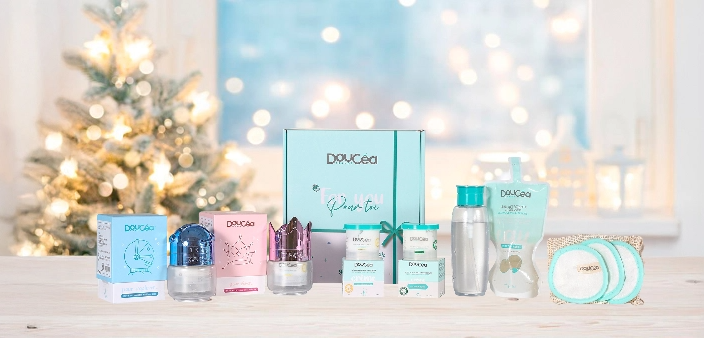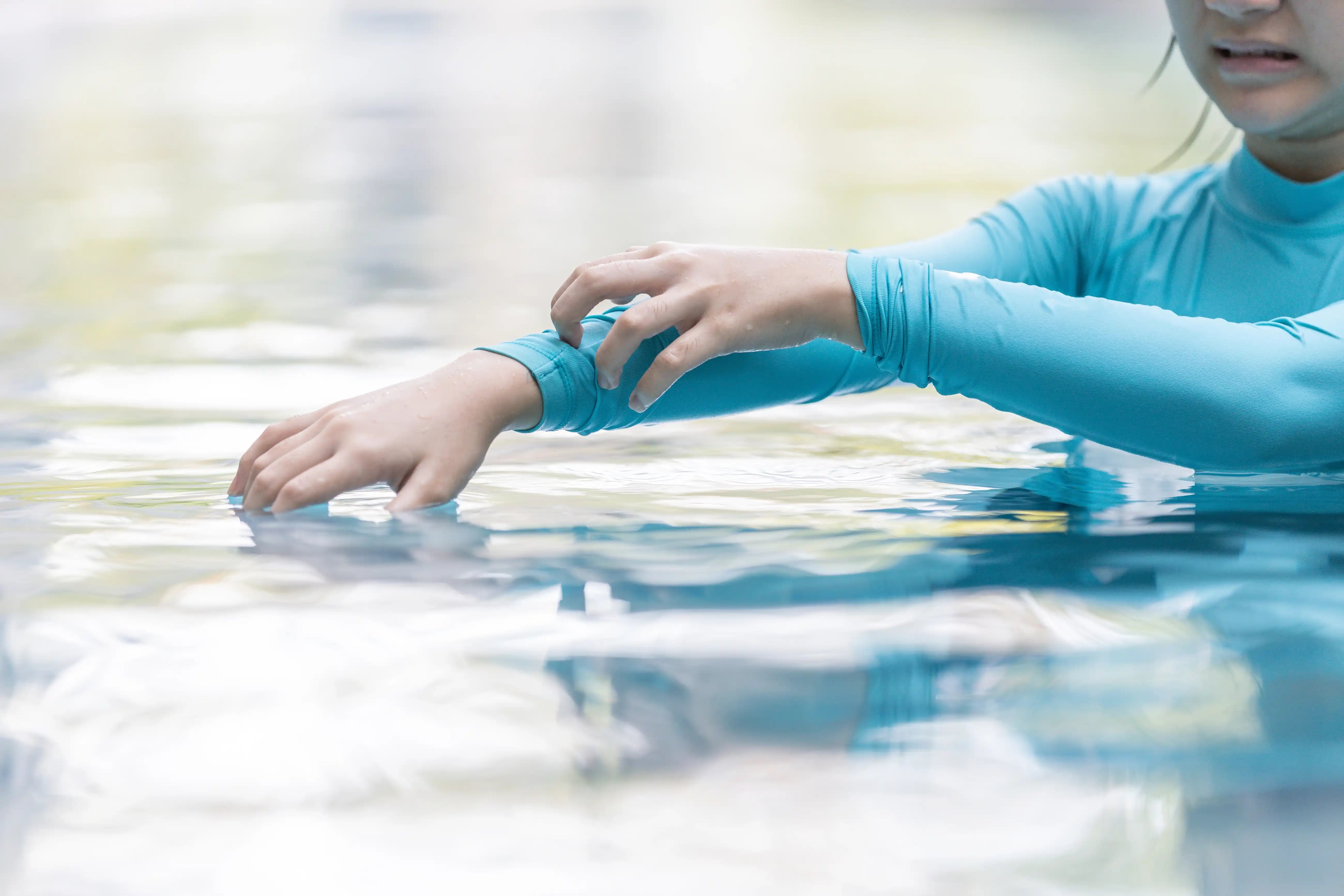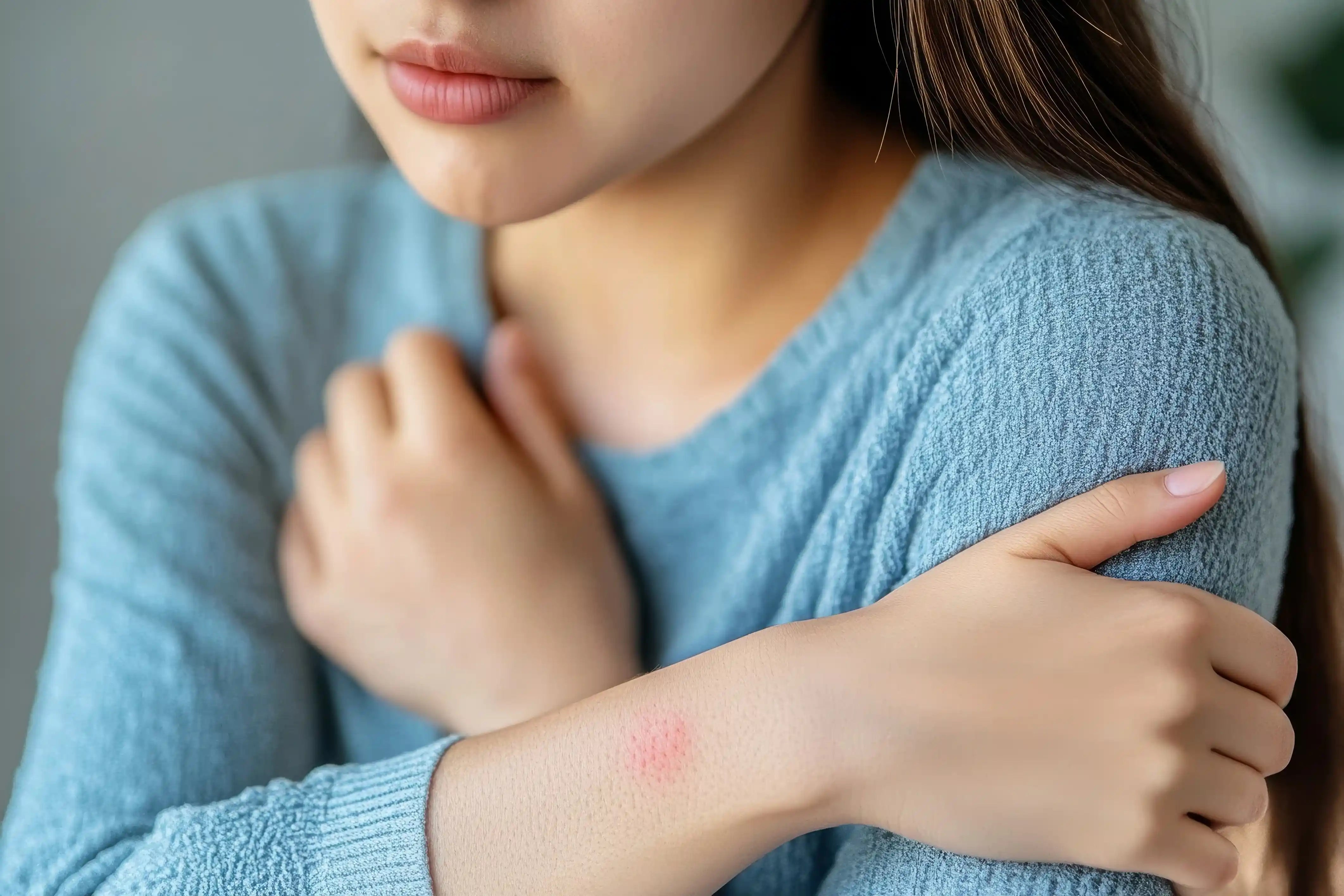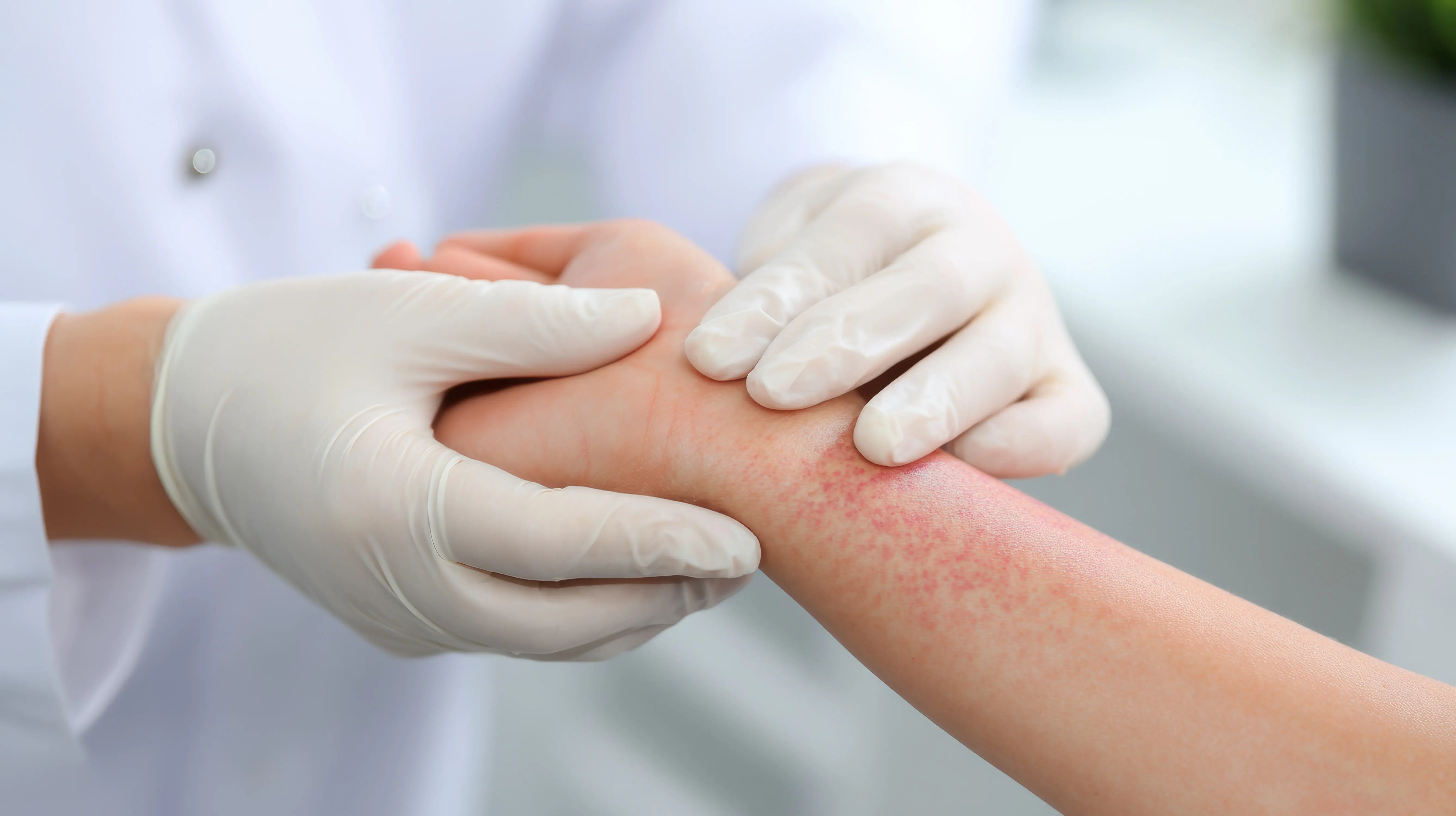Understanding Chlorine Allergy
Pool chlorine is an essential disinfectant, but in some people (especially children with sensitive skin) it can cause skin irritation and respiratory discomfort.
What is a chlorine allergy?
Many people mistakenly attribute their pool discomfort to a "chlorine allergy." In reality, chlorine itself is not an allergen in the classic sense: it's an ion naturally present in the human body and in our diet, and it doesn't cause a direct allergic immune reaction. The term "chlorine allergy" commonly refers to a skin or respiratory reaction triggered by chlorinated water, without there being a true underlying allergic mechanism. It's more of a hypersensitivity or irritation caused by chlorine-derived products than an allergy per se.
Allergy or skin irritation: how to tell the difference?
In a true allergy, the immune system is involved: it reacts excessively to a normally harmless substance. On the contrary, a chlorine irritation or intolerance doesn't involve immunity: it results from a direct chemical action of chlorine on the skin or mucous membranes. Concretely, a true allergy manifests at every contact, even minimal, with the allergen, whereas an irritation mainly depends on the chlorine concentration and individual sensitivity.
The role of chloramines in skin reactions
The main culprit behind pool irritations is not so much pure chlorine as chloramines. These volatile chemical compounds form when chlorine reacts with organic matter present in the water (sweat, dead skin cells, saliva, urine). Chloramines are what give the pool its typical strong chlorine smell, as chlorine itself is odorless. However, chloramines are very irritating to the skin, eyes, and respiratory tract: by evaporating at the water's surface, they come into contact with our eyes and mucous membranes and can trigger redness, stinging, or coughing.
Is chlorine allergy common?
From a medical standpoint, true immunological chlorine allergy is exceptionally rare. However, hypersensitivity reactions or irritation due to chlorine and chloramines are relatively common. Red eyes that sting, skin that feels tight or shows eczema, coughing after swimming... so many widespread manifestations that are mistakenly called chlorine allergy. These discomforts mainly affect people with sensitive conditions (dry skin, eczema, asthma) and regular swimmers.
What are the symptoms of a chlorine allergy?

Skin symptoms: redness, itching, eczema, dryness
When sensitive skin comes into contact with chlorinated water, it can react with various skin symptoms. The most common are diffuse redness or patches, intense itching (pruritus), a sensation of hot or tight skin, or even the appearance of small eruptions or eczema patches on exposed areas. In reality, it's usually an irritant contact dermatitis caused by chlorine: the skin is attacked and its protective hydrolipidic film is altered, which leads to inflammation and dryness. Children who already have atopic-prone skin are particularly susceptible to experiencing these redness and eczema after bathing, as their skin barrier is more vulnerable.
Respiratory symptoms: cough, shortness of breath, irritation
Chlorine exposure can also affect the respiratory tract, especially in poorly ventilated indoor pools where volatile chloramines stagnate above the water. Respiratory symptoms typically include a persistent dry cough after bathing, sneezing, an irritated throat with a tingling sensation, as well as a runny nose. In some people, particularly those with an asthmatic background, inhaling chloramines can cause more severe symptoms: chest tightness, shortness of breath, wheezing, or even a true asthma attack.
Ocular symptoms: red eyes, stinging, tearing

Ocular symptoms are among the most immediate of chlorine irritation. Eyes exposed to chlorinated vapors often become red and bloodshot, with an unpleasant burning or stinging sensation. Eyes may also water profusely and be sensitive to light. This is irritant keratoconjunctivitis – an inflammation of the eye surface caused by the chemical irritant. Contact lens wearers should be extra careful as chlorine can damage lenses.
Causes and aggravating factors
Individual sensitivity and allergic predisposition
People considered atopic – having a family predisposition to allergies, eczema, asthma – are more likely to react to chlorine. In a child with very fair and reactive skin or a history of eczema, chlorine will more easily trigger redness and itching. Skin that is already dry or fragile at baseline will have difficulty tolerating the harsh effect of chlorine. It's a vicious cycle: chlorine worsens skin dryness, and the drier the skin, the more vigorously it reacts to chlorine.
Chlorine concentration in pools and tap water
The more heavily chlorinated the pool water, the higher the risk of irritation. An over-chlorinated pool can cause skin reactions even in people who are normally not very sensitive. Public pools can contain between 1 and 2 mg/L of chlorine, concentrations that pose problems for fragile skin. In contrast, tap water contains chlorine at very low doses (about 0.1 mg per liter) which normally isn't enough to cause hypersensitivity.
Duration and frequency of chlorine exposure
The more frequent and prolonged the exposure, the more the irritating effects of chlorine accumulate. A child who swims once a month will have fewer skin problems than a child who goes to the pool twice a week all year. Staying an hour in chlorinated water means an hour during which chlorine exerts its drying and irritating action on the skin and eyes.
Sensitive or atopic-prone skin: a more vulnerable condition
Sensitive, dry or atopic-prone skin constitutes a breeding ground for chlorine reactions. By atopic-prone skin, we mean the skin of people suffering from constitutional eczema: it's genetically drier skin that doesn't play its barrier role well and easily allows irritants to penetrate. In these children, chlorine can cause true eczema "flare-ups" with rough red patches accompanied by intense itching. A child who has eczema isn't allergic to chlorine per se, but chlorine acts in them as an irritating factor that triggers or worsens their lesions.
How to recognize a chlorine allergy?
When to consult a doctor or dermatologist?
Faced with unusual symptoms in your child after bathing, the golden rule is: when in doubt or if there's significant discomfort, it's better to consult. You should consult if:
- Symptoms are very pronounced (extensive eczema, frank respiratory difficulties)
- Symptoms last beyond 1 to 2 days after exposure
- You're not sure it's chlorine
- The child is under 1 year old or has complex medical history
Emergency consultation is indicated if your child presents acute respiratory difficulties, facial or lip swelling, repeated vomiting, or malaise.
Allergy tests and examinations
If a true allergy is suspected, an allergist may offer allergy tests: skin tests (prick-tests or patch-tests), blood tests looking for specific IgE, or in some cases a controlled provocation test. The objective of these examinations is often to rule out other causes. If it turns out that all allergy tests are negative, this will confirm that we're dealing with an irritative allergic reaction and not a classic allergy.
How to soothe a chlorine allergy?
Medical treatments: antihistamines, soothing creams
Depending on the severity of symptoms, the doctor may recommend:
- Antihistamines to reduce itching and redness
- Soothing and anti-inflammatory creams (low-dose topical corticosteroids for significant lesions)
- Bronchodilators if the child presents marked respiratory symptoms
- Soothing eye drops for very irritated eyes
- Moisturizing care to restore the skin barrier
Immediate actions after chlorine exposure
Certain immediate actions can alleviate symptoms:
- Get out of the water at the first signs of irritation
- Rinse the skin and hair abundantly with clear water for several minutes
- Rinse the face, eyes, and mucous membranes with saline solution
- Gently dry by patting and cover immediately
- Apply a soothing cream on the skin
- Reassure and calm the child
Hydration and protection of sensitive skin
After bathing, generously moisturizing your child's skin with a suitable cream helps repair the skin barrier weakened by chlorine.
Right after the pool, once the child is rinsed and dried, immediately apply a moisturizing and soothing cream all over the body. Choose a care product formulated for sensitive or atopic-prone skin, without perfume or aggressive ingredients. This simple gesture helps counterbalance the drying effect of chlorine and prevent the appearance of eczema.
Outside of pool days, continue to care for your child's sensitive skin with daily maintenance. Well-moisturized skin is the best defense against chlorine irritation. The more supple and healthy their skin is, the less power chlorine will have to dry it out and make it react.
Avoid or limit repeated contacts with chlorine
For particularly sensitive children, a few adjustments can make a difference:
- Space out pool sessions
- Shorten bathing duration (30 to 45 minutes may be enough)
- Avoid unnecessary exposures (very crowded pools)
- Replace some activities with swimming in the sea or lake
- Adapt seasons (reduce in winter when skin is already dried out)
Doucéa products to protect sensitive skin
Doucéa, a French natural cosmetics brand dedicated to sensitive skin of babies and children, offers a range specially designed to protect and soothe skin after chlorine exposure.
APAISÉA Cream: optimal hydration and protection
The APAISÉA Cream is specially designed for sensitive or fragile skin. Enriched with prebiotics and 100% natural inulin, a trio of natural oils (sweet almond, sunflower seed, jojoba extract), vitamin E, and organic cornflower floral water, it offers optimal hydration and soothes irritations caused by pool water. Apply it generously after each swim to restore your child's skin barrier.
DOUTOPIA Cream: intense nutrition for very dry skin
For children with atopic-prone or very dry skin, the DOUTOPIA Cream provides intense nutrition and soothes irritations. Its formula contains madecassoside (Centella Asiatica), a 100% natural prebiotic, a trio of natural oils, a complex of moisturizing sugars, and vitamin E. Used daily, it strengthens the skin and makes it less vulnerable to aggressions like chlorine.
DOUCEA Water: gentle cleansing after the pool
The Doucéa cleansing and soothing water is a natural solution for cleaning children's delicate skin after bathing. Enriched with Alpha-Glucan Oligosaccharide prebiotics, Lactobacillus Ferment probiotic, chamomile and cornflower floral water, it removes chlorine residues while respecting sensitive skin. Perfect for a quick face cleanse after the pool.
Preventing chlorine allergy
Limit bathing time and rinse skin abundantly
Limit your child's bathing time according to their tolerance. For toddlers, 20-30 minutes in chlorinated water can already be a lot. When the session is over, don't delay taking a complete shower: immediate abundant rinsing eliminates most of the chlorine before it causes too much damage. This "short bath + long shower" combo will greatly preserve their skin and health.
Shower before and after the pool
The shower before has a dual benefit: it wets the skin (already hydrated skin absorbs less chlorine), and it eliminates sweat and dirt that would react with chlorine to form irritating chloramines. The shower after is crucial to rid the skin and hair of all chlorine. Use a mild, superfatted, fragrance-free soap with neutral pH. Thoroughly rinse mucous membranes (nose, mouth).
Choose better-treated pools
Not all pools are equal. If your child reacts a lot to chlorine, favor pools using alternative methods: salt electrolysis, ozone treatment, ultraviolet (UV) or bromine treatment. These systems reduce the amount of chlorine needed and thus decrease irritations. Avoid pools that smell too strongly of chlorine right at the entrance: a pungent smell means the water is saturated with irritating chloramines.
Protect eyes and skin with goggles and appropriate clothing
For the eyes, the essential accessory is a good pair of waterproof swimming goggles. This will prevent direct contact of chlorinated water with the conjunctiva. For the skin, you can use covering swimwear: a UV-protective t-shirt or a light lycra wetsuit will limit surfaces exposed to chlorine.
Conclusion

"Chlorine allergy" is generally not an allergy in the strict sense, but an irritative reaction caused by chloramines. The good news is that there are many solutions to prevent and alleviate these reactions. Simple gestures like showering before/after bathing, thorough rinsing of the skin, using moisturizing creams after the pool, and wearing swimming goggles can transform your child's experience.
As a parent, you can create a routine that will allow your child to enjoy the joys of the pool without suffering. With kindness and vigilance, and by using suitable products like those from Doucéa, every child deserves to have fun in the water safely, even if they have fragile skin.
If despite all your precautions your child continues to have troublesome reactions, consult a healthcare professional. Chlorine intolerance shouldn't make you give up aquatic pleasures. By applying these prevention tips, you will significantly improve your little swimmer's comfort. With well-protected and well-moisturized skin, your child will be able to splash around in complete peace!
















